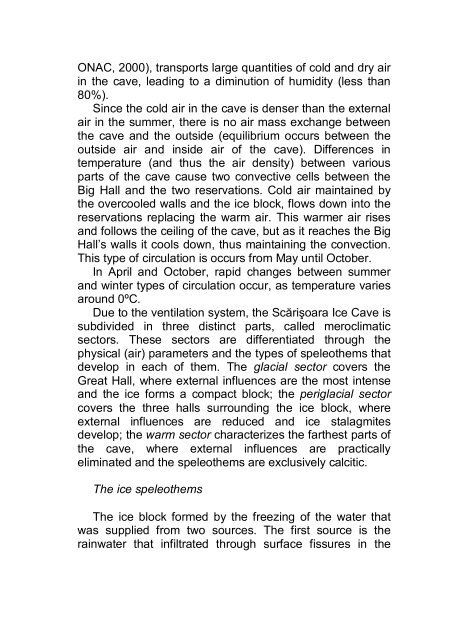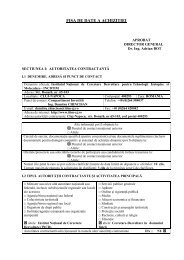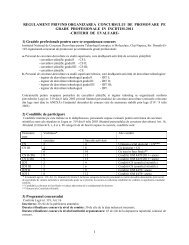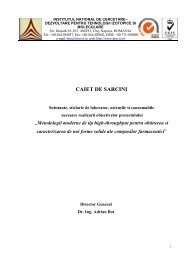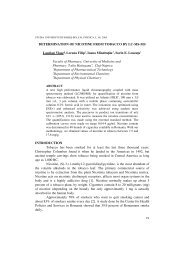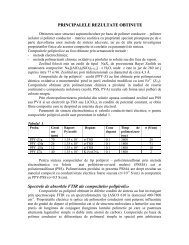Karst and caves in the Bihor Mountains - ITIM
Karst and caves in the Bihor Mountains - ITIM
Karst and caves in the Bihor Mountains - ITIM
- No tags were found...
You also want an ePaper? Increase the reach of your titles
YUMPU automatically turns print PDFs into web optimized ePapers that Google loves.
ONAC, 2000), transports large quantities of cold <strong>and</strong> dry air<strong>in</strong> <strong>the</strong> cave, lead<strong>in</strong>g to a dim<strong>in</strong>ution of humidity (less than80%).S<strong>in</strong>ce <strong>the</strong> cold air <strong>in</strong> <strong>the</strong> cave is denser than <strong>the</strong> externalair <strong>in</strong> <strong>the</strong> summer, <strong>the</strong>re is no air mass exchange between<strong>the</strong> cave <strong>and</strong> <strong>the</strong> outside (equilibrium occurs between <strong>the</strong>outside air <strong>and</strong> <strong>in</strong>side air of <strong>the</strong> cave). Differences <strong>in</strong>temperature (<strong>and</strong> thus <strong>the</strong> air density) between variousparts of <strong>the</strong> cave cause two convective cells between <strong>the</strong>Big Hall <strong>and</strong> <strong>the</strong> two reservations. Cold air ma<strong>in</strong>ta<strong>in</strong>ed by<strong>the</strong> overcooled walls <strong>and</strong> <strong>the</strong> ice block, flows down <strong>in</strong>to <strong>the</strong>reservations replac<strong>in</strong>g <strong>the</strong> warm air. This warmer air rises<strong>and</strong> follows <strong>the</strong> ceil<strong>in</strong>g of <strong>the</strong> cave, but as it reaches <strong>the</strong> BigHall’s walls it cools down, thus ma<strong>in</strong>ta<strong>in</strong><strong>in</strong>g <strong>the</strong> convection.This type of circulation is occurs from May until October.In April <strong>and</strong> October, rapid changes between summer<strong>and</strong> w<strong>in</strong>ter types of circulation occur, as temperature variesaround 0ºC.Due to <strong>the</strong> ventilation system, <strong>the</strong> Scărişoara Ice Cave issubdivided <strong>in</strong> three dist<strong>in</strong>ct parts, called meroclimaticsectors. These sectors are differentiated through <strong>the</strong>physical (air) parameters <strong>and</strong> <strong>the</strong> types of speleo<strong>the</strong>ms thatdevelop <strong>in</strong> each of <strong>the</strong>m. The glacial sector covers <strong>the</strong>Great Hall, where external <strong>in</strong>fluences are <strong>the</strong> most <strong>in</strong>tense<strong>and</strong> <strong>the</strong> ice forms a compact block; <strong>the</strong> periglacial sectorcovers <strong>the</strong> three halls surround<strong>in</strong>g <strong>the</strong> ice block, whereexternal <strong>in</strong>fluences are reduced <strong>and</strong> ice stalagmitesdevelop; <strong>the</strong> warm sector characterizes <strong>the</strong> far<strong>the</strong>st parts of<strong>the</strong> cave, where external <strong>in</strong>fluences are practicallyelim<strong>in</strong>ated <strong>and</strong> <strong>the</strong> speleo<strong>the</strong>ms are exclusively calcitic.The ice speleo<strong>the</strong>msThe ice block formed by <strong>the</strong> freez<strong>in</strong>g of <strong>the</strong> water thatwas supplied from two sources. The first source is <strong>the</strong>ra<strong>in</strong>water that <strong>in</strong>filtrated through surface fissures <strong>in</strong> <strong>the</strong>


